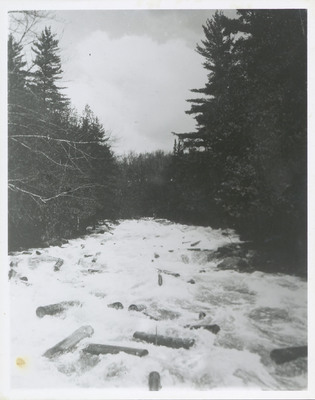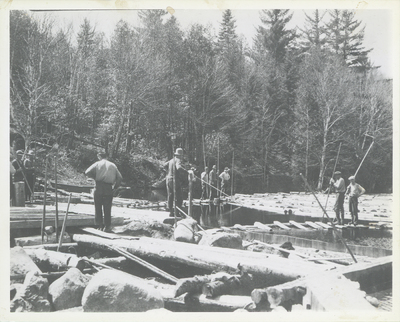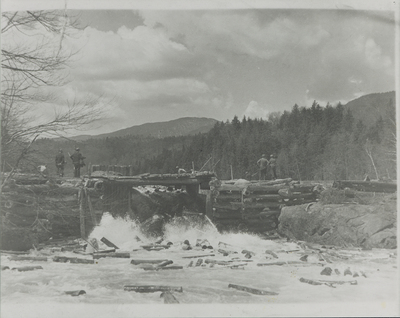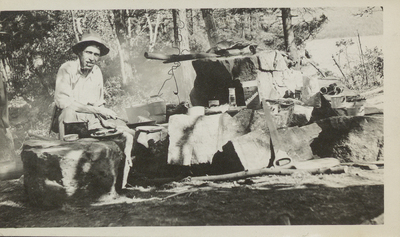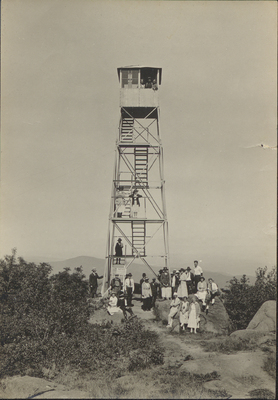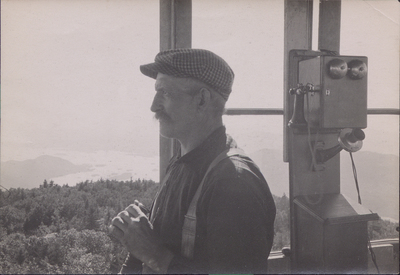This Land is Your Land
Rampant logging threatened the forests of the Adirondacks. When writer George Perkins Marsh published Man and Nature in 1864 he raised awareness about the dangers posed by decimated wildlands. A best seller, the book sparked a national, political debate about the merits of preservation, eventually leading to the New York’s ‘Forever Wild’ constitutional amendment in 1894, which has effectively protected and preserved the Catskill and Adirondack regions for the past century.
Initially, the timber industry in the Adirondacks grew slowly due to the difficulty of transporting felled trees out of the remote region. Significant logging and lumbering began in the Adirondacks around 1813, and by 1850, New York had surpassed Maine to become the largest producer of lumber in the United States.1 Industrial growth and urban expansion fueled the demand for lumber. As America expanded westward, prospectors sought lumber from the old-growth forests of the Adirondacks. American railroad expansion increased the rate of logging. Only two ties “as a rule could be cut from a single tree”.2 As a result, it is estimated that during the railroad expansion boom (1810-1890) 30 million to 60 million trees were consumed per year.3
Before the expansion of timbering in the Adirondacks, lumbermen transported trees from the forests to mills by thatching logs into rafts and floating them down waterways. Teams of mules and men would haul the log-rafts overland around obstacles, waterfalls, or cascades.4 The log-raft method, however, was not successful in the mountainous terrain of the Adirondacks, so a new technique was developed: the “loose-log drive”. Large groups of un-thatched logs were “driven” (floated) down rivers and streams.5 Tree felling took place close to rivers and streams in the fall and early winter. Lumbermen would then strip the trees of their bark and limbs before leaving everything on the forest floor until returning in the early spring. This cycle allowed the logs to cure for a season while also utilizing the high water levels and quick currents of the spring melt for their transportation. Softwood trees, such as pine, hemlock, and spruce, rather than hardwoods, such as maple and birch, quickly became the focus of the loggers as the greater buoyancy of the softwood trees led to easier transport.6 The techniques developed in the Adirondacks influenced logging nationwide.
The rampant loose-log drives in the Adirondack region distressed riverfront property owners. The unsecured logs damaged delicate shorelines and monopolized water traffic. In order to protect the timber industry from the complaints of property owners, the New York State Legislature declared many portions of rivers in the Adirondacks “public highways” between 1806 and 1846. This designation gave loggers full authority to use these waterways for lumber transportation.7 By 1885 logging had removed between “fifteen to thirty percent of the forest cover”8 of the 6.1 million-acre region. This equates to between 915,000 and 1,830,000 acres of denuded forest. “No area in America has had a more miserable story [than the Adirondacks] of ruthless squandering of natural resources and of carelessness based on the supposition that the stock of… trees, was infinite”.9
1 Paul Schneider, The Adirondacks: A History of America’s First Wilderness. (New York: Henry Holt and Company, 1997): 202.
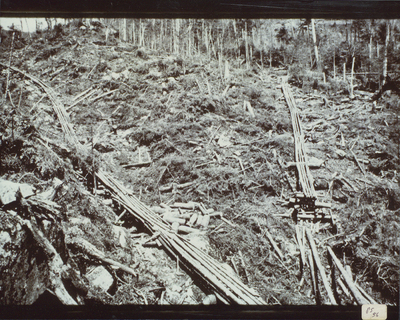
Photograph showing a hillside that has been lumbered and has sluiceways constructed on it to help send logs downhill, in the High Peaks of the Adirondack Park.

Stumps caused as a result of clear-cutting on the shore of the Raquette Lake Reservoir looking east. The dam is visible in the extreme distance, 1930s.
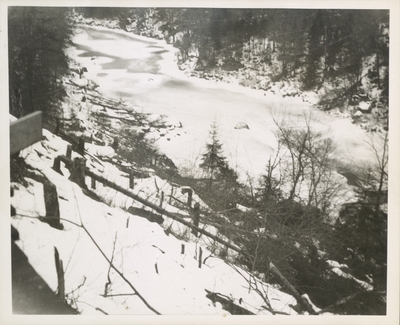
Trees cut down on state land at the proposed site of the Panther Mountain Dam with the Moose River in the background, in winter. Paul Schaefer and the Adirondack Moose River Committee took this picture as part of a trip they made to record illegal tree cutting activity relating to the Panther Mountain Dam, circa 1946.
In 1864, George Perkins Marsh published Man and Nature. The book raised public awareness about how significantly humans impact their environment. A best seller, the book ignited a social fervor in the hearts of Americans, profoundly altering environmental attitudes and ideas about conservation.1 In Man and Nature, Marsh argued for rational resource management, specifically in reference to logging. He believed deforestation was “the most destructive among many causes of the physical deterioration of the earth.”2 Marsh claimed that deforestation led to the degeneration of forest soil and ultimately to ecological collapse. He argued that as deforestation occurs, the land loses its ability to hold and manage water fluctuations. Wetlands dry up, spring runoffs increase, and rates of erosion accelerate.3 Marsh drew direct parallels between the fallen empires of antiquity and the current state of the Adirondacks, stating that the effects of over-logging “are already perceptible”.4
Marsh called upon New York State to conserve the Adirondacks for both its environmental protection as well as the enjoyment of the commonwealth, stating that:
It is desirable that some large and easily accessible region … should remain… in its primitive condition … for the recreation of the lover of nature … in the enjoyment of such imperfect protection and the laws of a people.5
Man and Nature raised awareness that unchecked logging in the Adirondacks had led to dangerous levels of erosion that could clog the Erie Canal and affect “the navigation of the Hudson”.6 The Erie Canal system, which linked the eastern seaboard with the western interior of the country, was indispensable to New York’s economy.7
In order to assess these threats the New York State Legislature commissioned Verplanck Colvin to survey the Adirondacks in 1872. Colvin’s 1873 report to the legislature intensified concerns when he stated that the loss of tree cover would affect the drinking water supply for New York City and the downstate region by reducing the amount of water available and polluting the remainder. 8In his second report in 1874, Colvin further argued that:
Unless the region be preserved essentially in its present wilderness condition, the ruthless burning and destruction of the forest will slowly, year after year, creep onward after the lumbermen, and vast areas of naked rock, arid sand and gravel will alone remain.9
It was thus utilitarian, water-based arguments (devoid of aesthetic, recreational, or spiritual reasoning) that formed the foundation of the Adirondack Park and New York State’s Forest Preserve.
In 1883, the New York State Legislature formed a committee to examine the possibility of preserving state-owned land in the Adirondacks. In 1885, a law was passed forming the Forest Preserve. This law protected state-owned lands from being sold and created a Forestry Commission charged with the oversight, management, and sale of timber from the lands. This commission was overwhelmingly recognized as inadequate in scope and a failure in execution. Combined with droughts and forest fires in 1893 and 1894, this led to fearful outcries that the watershed of New York was being destroyed by logging.10
1 David Lowenthal. “Nature and Morality from George Perkins Marsh to the Millennium” Journal of Historical Geography 20 no. 1 (2000): 4.
2 George Perkins Marsh. Man and Nature. (New York: Charles Scribner, 1864): 217.
3 Paul Schneider, The Adirondacks: A History of America’s First Wilderness. (New York: Henry Holt and Company, 1997): 220.
4 George Perkins Marsh. Man and Nature. (New York: Charles Scribner, 1864): 236.
5 Ibid. 235.
6 Ibid. 235.
7 Philip G. Terrie. Forever Wild: Environmental aesthetics and the Adirondack Forest Preserve. (Philadelphia: Temple University Press, 1985): 95.
8 Verplanck Colvin. Report on the Topographical Survey of the Adirondack Wilderness of New York for the year 1873. (Albany: Weed, Parsons and Company, 1874): 115.
9 Verplanck Colvin. Report on the Topographical Survey of the Adirondack Wilderness of New York for the year 1874. (Albany: Weed, Parsons and Company, 1874): 116.
10 Philip G. Terrie. Forever Wild: Environmental aesthetics and the Adirondack Forest Preserve. (Philadelphia: Temple University Press, 1985): 100.
In 1892, a law was passed forming the Adirondack State Park and Catskills State Park to encompass the areas endangered by logging. This law, however, removed previous protections against the sale of state-owned lands. In response, Assemblyman David McClure of New York City introduced an amendment, written by Louis Marshall, during the 1894 New York State Constitutional Convention that defined and expanded the protection of the Forest Preserve. Article VII, Section 7 read:
The lands of the State, now owned or hereafter acquired, constituting the forest preserve as now fixed by law, shall be forever kept as wild forest lands. They shall not be leased, sold or exchanged, or be taken by any corporation, public or private, nor shall the timber thereon be sold, removed or destroyed.1
The passage of Article VII, Section 7, known as “Forever Wild,” led to the formal creation of the Forest Preserve within the Adirondack and Catskills State Parks in 1894.
This, in turn, generated conflicts between state officials and local residents. Management of the Adirondack State Park was complicated by the fact that the “blue line” (the boundary around the park) has always encompassed a patchwork of privately and publicly owned lands. National leaders in the conservation movement, such as Marsh, Colvin, and Gifford Pinchot, viewed the residents within the newly formed park as uneducated, untrustworthy woodsmen who exploited the land for personal gain. Adirondack residents, on the other hand, felt victimized by social and class prejudices. The new regulations dictated the use of the park’s natural resources, which criminalized the locals’ traditional hunting and logging subsistence lifestyles. Frustrated by sudden impositions of regulation over the use of what they saw as private property, many residents sold their property and left. Wealthy proprietors from downstate quickly purchased these properties in order to create expansive estates within the Adirondack Park.2
Although the creation of the Forest Preserve helped protect the land, it was too late to prevent many consequences from the 19th century’s over-logging. Prior to the timber boom, forest fires were a rare occurrence in the region3 as the natural ecology (thick cover, dense woods, and a moist forest floor) was a bulwark against fire.4 However, the cleared spaces, filled with piles of dry branches, bark, and leaves left behind by years of logging, were incredibly volatile and susceptible to fire. Sparks came from many sources, and, no matter how small, they had the power to ignite these dangerous scraps into a raging forest fire. Between 1890 and 1910, the Adirondacks saw a sudden growth in the prevalence of forest fires. Two years in particular, 1903 and 1908, were exceptionally devastating.
1 The Constitution of the State of New York. (Albany: James B. Lyon, 1894): 187.
2 See: Jacoby, Karl. Crimes against Nature: Squatters, Poachers, Thieves, and the Hidden History of American Conservation. (Berkeley: University of California Press) 2001.
3 Barbara McMartin. The Great Forest of the Adirondacks (Utica, New York: North Country Books, 1994): 46.
4 Ibid.
In 1903, precipitation rates fell to their lowest point in more than 75 years. This, combined with temperatures soaring into the high 90s, dried the forest floor and set the stage for what became an explosive fire in the High Peaks region. Between April 20 and June 8, this forest fire consumed nearly 600,000 acres of public and private land in the Adirondack State Park. The 1903 blazes were blamed on poorly regulated logging and railroad companies. 1 In 1908, a wet spring led to an overgrowth of shrubbery which, by the end of an arid summer, had turned into brown, dry fuel. On September 9, 1908, a passing coal-powered Mohawk & Malone train shot off a spark which ignited a pile of brush. This small flame grew into a forest fire with a 12-mile radius consuming more than 30,000 acres in a single day. This fire reached temperatures so high that “barrels of nails melted into lumps”.2 Smoke as thick as fog clogged a 600-mile radius, covering both New York City and Quebec.3 In the end, the blaze had destroyed 368,000 acres.
In 1909, conservationists and state officials began to investigate the causes of fires in the Adirondack Park. Nearly 90 percent of Adirondack fires were attributed to general fire safety negligence from people who “never realize that [in the forest] they have a floor that is highly flammable.”4 Improperly extinguished campfires, smoking, and sparks from guns or coal-powered trains easily ignited the dried fuel left behind by the timber industry. In response, the state began what it believed was the most important and productive preventive measure: education. Following the 1908 fire, officials posted warnings about fire threats alongside railroad schedules inside the Adirondacks. Pamphlets were mailed to sportsmen in the state and fire notices were posted throughout the Preserve in high traffic areas.5
Since 1909, fire control methods such as fire patrols, observation stations (fire towers), telephone lines, roads, trails, and fire lines were installed inside the park. New legislation required loggers to “limb” trees (a process that allows logging debris to decompose naturally). Furthermore, all trains were required to burn oil instead of coal seasonally (from April 15 to October 31).6 In 1911, the federal Weeks Act established cooperation in fire control between state and federal authorities, and provided a federal match to state firefighting funds.
Today, Forever Wild still protects the Catskills and the Adirondacks. However, it has faced threats from the start, and environmentalists have had to remain vigilant during the 122 years since its passage. It is only because of the tireless work of dedicated conservationists such as John Apperson Jr. and Paul Schaefer that Forever Wild has remained wild.


